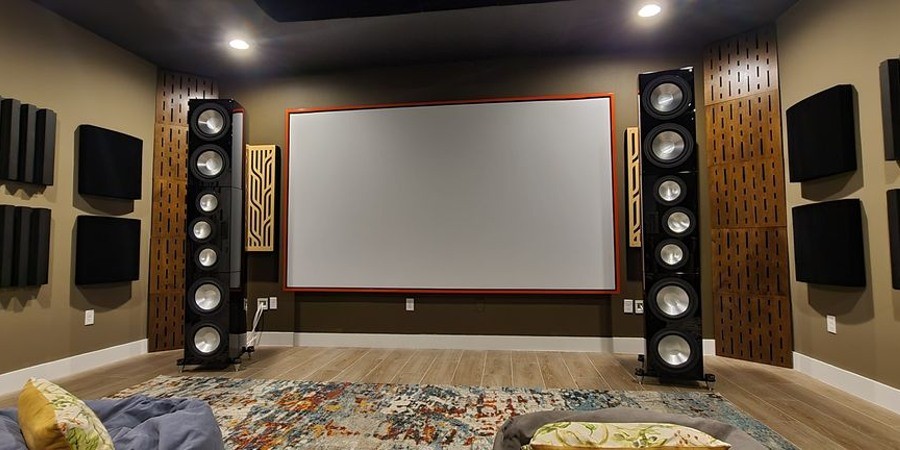Perfecting Sound: Audio Configuration and Calibration in Home Theater Installation
by siteadmin

In the realm of home entertainment, achieving crystal-clear audio is just as crucial as achieving stunning visuals. Audio configuration and calibration are vital steps in home theater installation, ensuring that every sound is reproduced faithfully and immersively. In this blog post, we’ll explore the importance of audio configuration and calibration in home theater setups, along with expert tips for achieving optimal sound quality and performance.
Understanding Audio Configuration:
Audio configuration involves setting up and connecting audio components, such as speakers, subwoofers, amplifiers, and receivers, to create a cohesive and immersive sound system. When configuring your home theater audio setup, consider factors such as speaker placement, room acoustics, and equipment compatibility. Determine the optimal speaker layout, including the number of speakers (e.g., 5.1, 7.1, or Dolby Atmos), their positioning, and their orientation relative to the viewing area. Ensure that audio components are compatible and properly connected to the audio source (e.g., Blu-ray player, streaming device, or gaming console) and the audio/video receiver.
Importance of Calibration:
Calibration is the process of fine-tuning audio settings and parameters to optimize sound quality, balance, and consistency throughout the listening area. Calibration ensures that audio levels, frequency response, and speaker performance are calibrated to the specific characteristics of the room and the listener’s preferences. Proper calibration eliminates inconsistencies in sound reproduction, such as volume disparities between speakers, uneven frequency response, and acoustic anomalies caused by room reflections and reverberations. Calibration also helps to achieve a seamless transition between speakers, creating a cohesive soundstage that envelops the listener in immersive audio.
Utilizing Room Correction Software:
Room correction software is a valuable tool for audio calibration, allowing users to analyze room acoustics and automatically adjust audio settings to compensate for acoustic anomalies and optimize sound quality. Many modern audio/video receivers feature built-in room correction software, such as Audyssey MultEQ, Dirac Live, or Yamaha YPAO, which use sophisticated algorithms to measure room acoustics, analyze frequency response, and apply corrective EQ adjustments to achieve optimal sound performance. By utilizing room correction software, homeowners can overcome acoustic challenges, such as room resonances, standing waves, and reflections, and achieve more accurate and consistent sound reproduction.
Conducting Manual Calibration:
In addition to automated room correction software, manual calibration techniques can further refine audio settings and tailor the sound to individual preferences. Manual calibration involves adjusting speaker levels, crossover frequencies, and EQ settings manually to achieve optimal sound balance and tonal accuracy. Use an SPL meter or a built-in test tone generator to measure and adjust speaker levels to ensure uniform sound pressure levels (SPL) across all speakers. Fine-tune crossover frequencies and EQ settings to optimize bass response and achieve a natural and balanced sound signature. Experiment with speaker placement and orientation to minimize room interactions and maximize sound clarity and imaging.
Testing and Tweaking:
After completing the calibration process, it’s essential to test the audio system thoroughly and make any necessary adjustments or tweaks to achieve the desired sound quality. Listen to a variety of audio content, including movies, music, and dialogue-heavy scenes, to evaluate sound performance across different genres and formats. Pay attention to dialogue clarity, soundstage width, imaging accuracy, and bass impact to identify any areas for improvement. Make incremental adjustments to speaker levels, EQ settings, and room treatments as needed to fine-tune the audio system and achieve optimal sound quality and immersion.
Audio configuration and calibration are critical steps in home theater installation, ensuring that every sound is reproduced accurately, dynamically, and immersively. By understanding the principles of audio configuration, utilizing room correction software, conducting manual calibration, and testing and tweaking the audio system, homeowners can achieve a home theater experience that rivals the immersive soundscapes of commercial cinemas. With meticulous attention to detail and careful calibration, you can elevate your home entertainment experience to new heights and immerse yourself in the breathtaking world of cinematic sound.
In the realm of home entertainment, achieving crystal-clear audio is just as crucial as achieving stunning visuals. Audio configuration and calibration are vital steps in home theater installation, ensuring that every sound is reproduced faithfully and immersively. In this blog post, we’ll explore the importance of audio configuration and calibration in home theater setups, along…
Recent Posts
- Streamlining Spaces: Enhancing Efficiency in Functionality Through Furniture Junk Removal
- Tranquility Unveiled: Creating Serenity Through Furniture Junk Removal
- From Clutter to Chic: Aesthetics and Design in Furniture Junk Removal
- Perfecting Sound: Audio Configuration and Calibration in Home Theater Installation
- Elevating Entertainment: Achieving Optimal Room Setup and Design for Home Theater Installation
